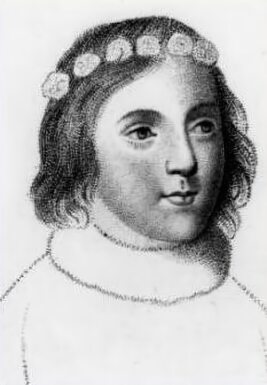25 February 1475 - 28 November 1499
Edward, 17th Earl of Warwick was the last male member of the House of Plantagenet. He was the son of George, Duke of Clarence, the brother of Edward IV and Richard IIII and of Isabel Neville, elder daughter of Richard Neville, 16th Earl of Warwick, known as 'Warwick the Kingmaker. He was born on 25 February 1475, at Warwick, the family home of his mother. The couple produced 3 other children, Anne who was born aboard a ship off Calais on 16 April 1470 and died at sea the following day. Margaret, Countess of Salisbury born on 14 August 1473 and Richard Plantagenet, who was born at Tewkesbury Abbey, in Gloucestershire on 6th October 1476, died at Warwick Castle on 1st January 1477 and was buried at Warwick.
Edward, Earl of Warwick
The young Edward experienced a turbulent childhood, his mother, Isabel Neville, died the year after his birth of either consumption or childbed fever, and his father, Clarence was executed for treason in the Tower of London two years later by Edward IV in 1478. Edward and his elder sister Margaret were left as orphans. He was created Earl of Warwick by King Edward IV in 1478 shortly after the attainder and execution of his father. The young Edward's wardship was purchased by Thomas Grey, Marquess of Dorset in 1481, in whose household he is believed to have spent the following two years. The Marquess of Dorset was the son of Queen Elizabeth Woodville by her first marriage.
During the short reign of his uncle Richard III, he was kept at Sheriff Hutton Castle in Yorkshire, as was Richard's nephew and heir, John de la Pole, Earl of Lincoln. Richard's niece, Elizabeth of York, later destined to become the mother of the formidable Henry VIII, was also housed at the castle for a spell when her suspected arrangement to marry the then pretender, Henry Tudor, (later Henry VII) placed her under suspicion.
Following King Richard's death at the Battle of Bosworth in 1485, Warwick, then ten years old, was brought to London and there imprisoned in the Tower by the new king, Henry VII. His claim to the throne posed a potential threat to the new Tudor dynasty, particularly after the appearance of the pretender Lambert Simnel in 1487.
Sheriff Hutton Castle
Simnel claimed to be the Earl of Warwick, he joined forces with Edward's cousin, John de la Pole, Earl of Lincoln, whom Richard III had proclaimed his heir. They were defeated at Stoke, Lincoln was killed on the battlefield. Simmel was treated leniently, he was pardoned and given a job in the royal kitchen by Henry VII. In order to prove Simmel was not the real Earl of Warwick, Henry VII had Edward paraded through the streets of London and displayed at St. Paul's. He was then returned to the Tower where he was denied all contact with the outside world.
In 1490, he was confirmed in the title of Earl of Warwick, although the attainder which had been placed on his father by Edward IV prevented him from inheriting the Dukedom of Clarence, his claim to the earldom of Warwick came from his maternal grandfather, Richard Neville, Earl of Warwick, but Edward remained a prisoner of Henry VII for the rest of his short life.
In 1499, the pretender Perkin Warbeck, a handsome young man with a superficial resemblance to Edward IV, led a rebellion against Henry VII, claiming to be Warwick's cousin, Richard Duke of York, the younger of the Princes in the Tower. He was captured and later sent to the tower.
A plot between Warwick and Warbeck aimed at their escape was alleged to have been hatched. On 21st November 1499, Warwick attended a trial before his peers at Westminster, presided over by John de Vere, Earl of Oxford. He pleaded guilty. A week later, at the age of 24, he was beheaded for treason on Tower Hill. Henry VII paid for his body and head to be taken to Bisham Abbey in Berkshire for burial
It was thought at the time that Warwick was executed in response to pressure from Ferdinand II of Aragon and Isabella I of Castile, whose daughter, Catherine of Aragon, was to marry Henry's heir, Arthur Tudor, Prince of Wales. Catherine was later reported to feel guilty about Warwick's death, and that her trials in later life were punishment for it. She applied these miseries and disasters to have happened for the death of Prince Edward Plantagenet, son of the Duke of Clarence, brother to King Edward the Fourth; whom (most innocent) Henry VII. put to death to make the kingdom more secure to his posterity, and to induce King Ferdinand to give his daughter, this Catharine, in marriage to Prince Arthur".
It has been claimed that Warwick was mentally retarded, this surmise is based entirely on a statement by the Tudor chronicler Edward Hall that Warwick had been kept imprisoned for so long "out of all company of men, and sight of beasts, in so much that he could not discern a Goose from a Capon". It could be that Hall meant that the long imprisonment he had undergone from a young age had made Warwick intellectually limited by a lack of education and deprivation of company and freedom. Upon Warwick's death, the House of Plantagenet became extinct in the legitimate male line. His sister Margaret, Countess of Salisbury, known as 'the last of the Plantagenets' survived until 1541, when she was executed for treason on the order of her cousin Henry VIII.
The Ancestry of Edward, Earl of Warwick
Edward Plantagenet Earl of Warwick
Father: GeorgeDuke of Clarence
Paternal Grandfather: Richard Duke of York
Paternal Great-grandfather: Richard, Earl of Cambridge
Paternal Great-grandmother: Anne Mortimer
Paternal Grandmother: Cecily Neville
Paternal Great-grandfather: Ralph Neville, Earl of Westmorland
Paternal Great-grandmother: Joan Beaufort
Mother: Isabel Neville
Maternal Grandfather: Richard Neville, Earl of Warwick
Maternal Great-grandfather: Richard Neville, Earl of Salisbury
Maternal Great-grandmother: Alice Montacute
Maternal Grandmother: Anne Beauchamp
Maternal Great-grandfather: Richard Beauchamp, 13th Earl of Warwick
Maternal Great-grandmother: Isabel le Despencer
The Wars of the Roses PreviousNext Richard III Visitor Centre
